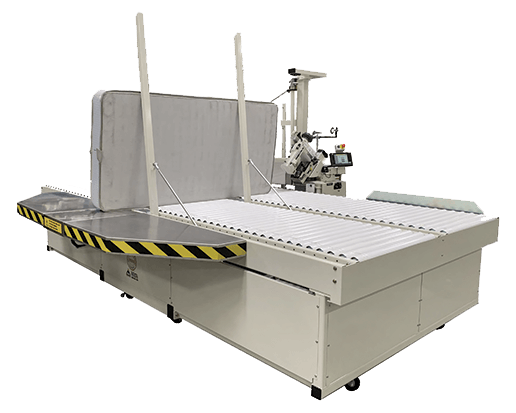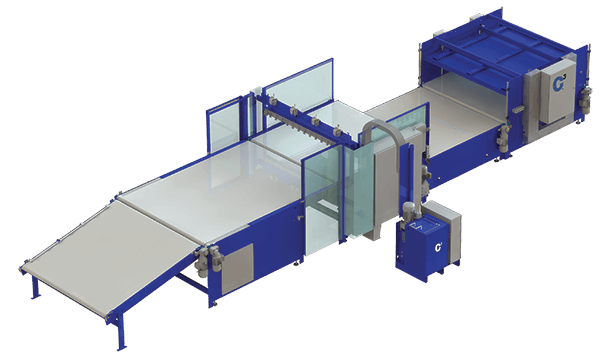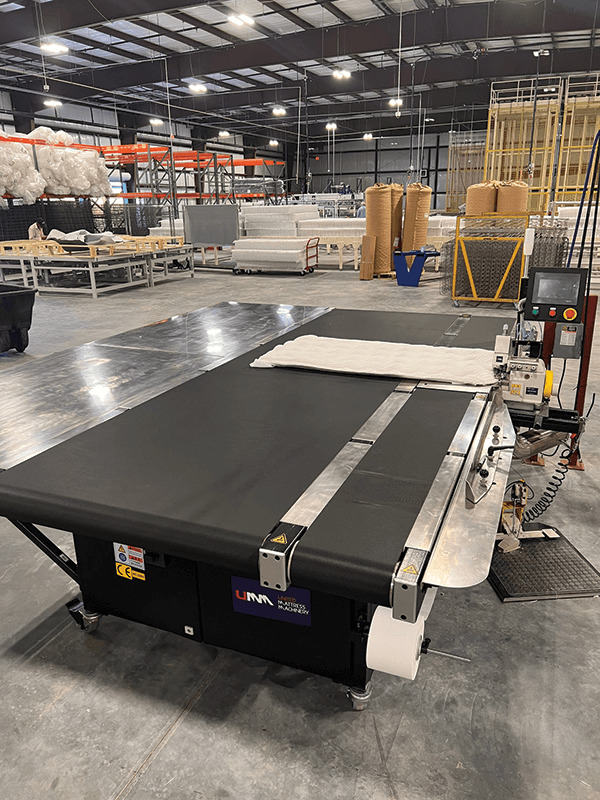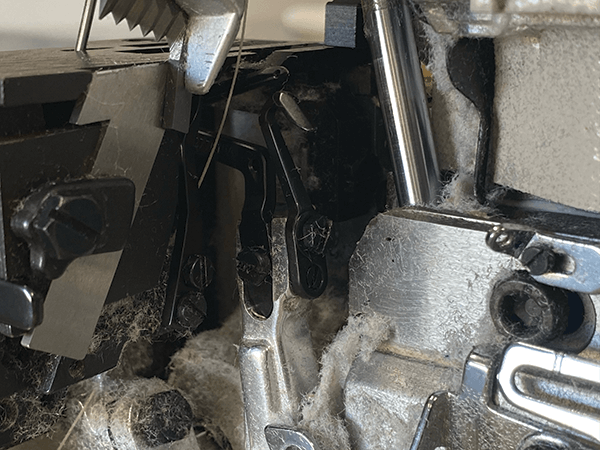Revolutionizing Sewing & Gluing Machinery: Cost Innovation

If there’s one word that comes up more than any other when discussing sewing and gluing machinery, it’s “less.”
Less labor, less money, less material, less waste, less energy. That’s what bedding producers are asking for, and that’s what machinery manufacturers are delivering through new technology and equipment.
Today’s sewing and gluing machinery is expected to cut costs and labor, while operating sustainably and helping customers set themselves apart in a market that’s becoming more and more competitive.
“Our customers are looking for opportunities to differentiate themselves … they’re challenging every aspect of building a mattress in search of a differentiating value proposition for their consumer,” says Joe Van De Hey, founder and CEO of C3 Corp. in Appleton, Wisconsin.
To stay ahead, C3 is focusing on making sure its machines are running efficiently. Further, it’s ensuring that today’s machine designs have an upgrade path to meet tomorrow’s production needs, he says.
“C3’s patent-pending hot-melt glue design is challenging the market to think differently about how we use less glue for a bond that is equally as strong, and with our technology we can control where the hot melt is applied,” Van De Hey says. “Throw on labor and waste efficiencies and our lamination solution running at 200 feet per minute is the industry leader.”
“Our customers are looking for opportunities to differentiate themselves.”
Hiring and retaining knowledgeable, experienced sewing machine staff is also a challenge for mattress manufacturers, according to Michael Porter Jr., vice president of sales for Delray Beach, Florida-based United Mattress Machinery.
“Our UM-5000 flange machine requires minimal maintenance — almost zero MRO (maintenance, repair, operations) — so you don’t need to tinker with the machine, never mind the spare parts replenishment lists that can be $200 to $2,000 per machine every couple of months,” Porter says. “Crazy, unnecessary money is spent on spare parts for flange machines, but not with the United UM-5000.”
On top of more traditional concerns, enter the new market demands for sustainability and the technical expectations of Industry 4.0, the fourth industrial revolution.
“Some regions of the worldwide market are gaining interest in sustainable manufacturing practices,” says Paul Block, president of sales for Global Systems Group, part of Carthage, Missouri-based Leggett & Platt. “Some are being mandated by government or industry groups, while some manufacturers are proactively self-regulating their operations because they appreciate the long-term benefits of using more eco-friendly practices.”
To meet those needs, GSG’s equipment is designed to reduce waste, whether that’s excess material trimmings, scrap rejects or nonvalue-add activities, he says.
“Some customers are cutting back work hours to minimize costs while capacity is low,” Block says. “GSG’s high-production-rate equipment helps them create higher volumes in shorter hours so they can still meet production demands with shorter workweeks.”
Meanwhile, Atlanta Attachment Co. is also homing in on Industry 4.0. The company is building on the computers and automation of the third industrial revolution by incorporating smart and autonomous systems.
“At Atlanta Attachment, we understand the significance of Industry 4.0 integration in today’s rapidly evolving manufacturing landscape,” says Hank Little, president of Lawrenceville, Georgia-based Atlanta Attachment. “By embracing this digital transformation, we have aligned our solutions with the principles of smart factories.”
“The Windows-based gateway system in our tape-edge machine line not only enables real-time monitoring and control but also facilitates the seamless integration of various production processes,” Little continues. “This integration ensures data-driven decision-making, predictive maintenance and improved overall efficiency, ultimately leading to enhanced productivity and profitability.”
To learn more about these dynamic machines and cutting-edge technologies, check out the following sections that detail key new pieces of equipment and how they can work on your plant floors.
Edgier tape-edge and glue

“As part of our commitment to providing comprehensive solutions, we have expanded our range of tape-edge machines,” says Hank Little, president of Atlanta Attachment Co. “The latest addition to our lineup is the groundbreaking 1315R, which incorporates roller technology and features a Windows-based gateway system with Industry 4.0 capability.”
Made with a rugged steel frame, the 1315R automatic tape-edge workstation features automatic mattress flipping (eliminating operator handling) and a simple roller design for easy roll replacement. Other features, according to the company, include electronic needle positioning and a backstop arm for accurate rotation, with smooth corner transitions and an adjustable corner sewing speed.
“This cutting-edge system enables seamless connectivity and data exchange between various components of the production line, facilitating efficient communication and improved decision-making,” Little says. “Furthermore, the 1315R offers wireless remote access to our technical service team, revolutionizing the way that remote support is provided. With this capability, our experts can swiftly diagnose and address issues, minimizing downtime and maximizing productivity for our customers.”
In addition, the company has invested significant resources to refine its gluing equipment.
“Recognizing the importance of minimizing glue consumption while ensuring strong bonding, our engineers have implemented more precise controls on rollers and nozzles, allowing for a minimal usage of adhesive while maintaining impeccable bond strength,” Little says. “By leveraging advanced technologies, we have accelerated the process of foam assembling, significantly reducing production time without compromising quality.”
Little points to a collaboration with Aper Srl and Umit Makina to create “groundbreaking gluing technologies that have been specifically designed to revolutionize the assembly process.”
Fast and accurate
The LCN1250 With Hot Melt Bridge is the new “hot topic” from C3 Corp., allowing customers to run at high speeds using minimal glue with a stronger bond, according to Joe Van De Hey, founder and CEO.
With a footprint of less than 700 square feet, the LCN1250 boasts a six-second throughput per layer and requires a minimum number of operators. It handles glue application, as well as lifting and placing the layers, so operators can make simple waist-height adjustments before sending it to the tamp press.

Van De Hey says here’s how it works: C3 comb tips apply glue efficiently with precise control of glue patterns and distribution. With uniformed sized product, (product size can vary from layer to layer) the actual placement can be plus or minus ¼ inch and operators can manually adjust the layers, if needed. Finally, the press section will help set the bond between the layers.
The C3 hot-melt bridge system uses two hoses: One hose feeds a manifold while the other hose recirculates the glue back to the melting tank to filter and create the cleanest possible glue. Clean glue allows for the best possible application and less overall maintenance, the company says. “In order to do all different types of laminates, we need the best quality glue and bond,” Van De Hey says. “If you are using a wide variety of materials, such as foam, latex layers, pocketed coil layers, etc., consider using the best quality glue for the best bond.”
The LCN1250 uses at least 30% less glue and gets the strength of a hot-melt bond without the hot-melt mess, according to Tom Wroblewski, C3 chief commercial officer and global compression leader. The company also has a patent-pending design for the precise control of glue patterns and distribution.
“C3’s patent-pending hot-melt design includes a high-speed continuous flow lamination process that eliminates glue charring while providing the control of where hot melt is applied exactly — every time at the glue weight required,” Wroblewski says. “It’s definitely an industry-leading solution.”
Automation equipment
In May, Global Systems Group exhibited an automated production line for hybrid mattresses at the Interzum trade show in Cologne, Germany. Its new TK-810 automatic FR sock covering machine could be integrated into that production line using no labor during normal operation.
“Whenever feasible, manufacturers should employ automation equipment,” says Paul Block, president of sales for GSG, part of Leggett & Platt. “Many manual tasks are redundant and add little value to the final production. Automation eliminates the labor for that process, making overall labor productivity more valuable, and it frees up limited staff to perform other work.”
The TK-810 automatically inserts a mattress core into a tube of FR material and closes each end of the covering with a secure, four-needle stitching process. One pair of needles closes the finished unit while the other set of needles closes the covering material that’s trailing behind the cut line, preparing the sock for the next incoming mattress core. This reduces the excess material that would otherwise be scrap behind the trimmed material, the company says.
In addition, GSG recently introduced the Ultra HCB Ergo binding machine, designed to join heavy border sections to quilt tops or flat goods decking. A strong Pfaff sewing head makes sewing easier for a wide range of materials, the company says. The machine includes an integrated air table and electronically controlled adjustable legs to position the work in the most comfortable position for employees.
“Ergonomic systems make employees more productive, simplify the work for better employee retention and reduce the risk of employee injuries,” Block says. “A comfortable worker is a more productive worker.”
Double the efficiency
“Nowadays, customers always request faster, more automated machines and good quality,” says Ariel Feng, who handles international sales for Hengchang Machinery Factory, based in Dongguan, China. “As a machine manufacturer, this is exactly what we are pursuing and achieving now.”
The company’s new HC-DB3000 is a high-speed, double-beam, double-head, single-needle quilting machine. Both sewing heads are from Dürkopp Adler and the entire machine is controlled by a Panasonic servo control system. Its rotation speed reaches up to 3,000 revolutions per minute, and the power output is as much as 16 kilowatts, which enables the HC-DB3000 to quilt thicker materials at a faster and more stable rate, the company says. In fact, the computerized machine can quilt two mattress pads at the same time, according to Feng.
In addition, Hengchang has updated its HC4000, a high-speed multineedle, chain-stitch quilting machine. At Interzum Cologne, the company demonstrated its advanced quilting technology. A CPU-controlled press plate height has a digital display and allows for different quilting thicknesses. The computerized machine can now reach speeds of 1,400 rpm (up from 1,350 rpm), with power output increased to 15 kilowatts (up from 10 kilowatts).
The HC4000 can be combined with the company’s four-side hammer machine and its automatic stacking machine in a production line to improve efficiency and reduce labor costs. “Hengchang is always looking for good quality and high technology in producing quilting machines to better supply high-quality machines to customers,” Feng says.
Decreasing costs
In 2020, United Mattress Machinery introduced the UM-5000 flange machine featuring improved walking foot technology, an enhanced linkage design and 135 fewer parts in the pressure and needle height systems. Today, that machine is still going strong, according to company officials.
The machine can sew panels from 3/8 inches thin to 6 inches thick, with a maximum sewing speed of 3,200 rpm. More than 20 of the key sewing components, including loopers, knives, needle guards and the walking foot linkage assembly, are coated with the company’s patented PTP surface treatment and backed by a one-year guarantee. PTP technology is a special surface treatment for metal components, granting better strength and durability to fast-moving parts and components — and increasing their life.

“The UM-5000 flange machine has performed better than our highest expectations,” says Michael Porter Jr., vice president of sales for the Delray Beach, Florida-based company. “We’ve sold around 200 machines … and the special PTP parts have performed incredibly well.”
“Out of all the UM-5000s we’ve sold, there have only been minimal spare-parts aftermarket sales for loopers, spreaders, linkage parts and beams,” he continued. “There have been pretty much zero MRO (maintenance, repair, operations) costs for UM-5000 customers, which has led most customers to buying their second or third machine. The United UM-5000 is that good.”
The reliable performance is also helpful for mattress makers because “good operators and technical people who know sewing machines are getting harder and harder to come by,” says Sam Porter Jr., chief operations officer. “So, we’re making their operation more efficient and deskilled, so that they don’t need someone with 15 to 20 years of sewing experience to work on a machine.”

Porter adds that customers have been asking for the flange machine, along with the automatic belt table, to help deskill the flange sewing operation and help maintain consistency in panel quality. The belt table allows beginning workers to sew consistent, high-quality panels with fewer errors.
“Mike Porter Sr. was able to create a flange machine from the ground up, the complete design from scratch, without significant modifications,” Porter says. “Applying the aerospace heat treatment proprietary to the consumable parts (PTP) is going to change the aftermarket parts industry for sewing equipment.”
